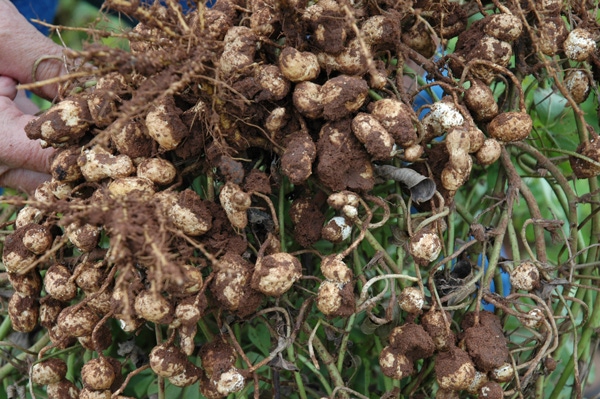July 5, 2011

Last year was a lesson in perseverance for many U.S. peanut producers, as a promising spring soon gave way to dry, extremely hot weather conditions during summer and early fall.
But thanks to near-perfect harvest weather and the performance of new varieties, some growers were rewarded with exceptional crops, including the 2011 Farm Press Peanut Profitability Award winners.
“All of these winners did an excellent job of managing their costs in a very extreme year without sacrificing yield,” says Marshall Lamb, research director for the National Peanut Research Laboratory in Dawson, Ga., and advisor for the Peanut Profitability Program.
Last year, peanut growers in the United States averaged 3,250 pounds with one of the worst droughts in years in areas of the lower Southeast and the Southwest, says Lamb.
Like Peanut Profitability winners from previous years, the 2011 honorees did an excellent job of managing fixed costs, he says. The awards are based on production from the previous year.
“It’s difficult many times for farmers to manage variable costs because of a dry year and increased irrigation costs. And, whenever, there’s a pest outbreak, they have to use more chemicals. But the one thing farmers can manage is their fixed or equipment costs, and these winners did an outstanding job of doing that.
“In more than 10 years of collecting data for this program, our winners always do an excellent job of managing fixed costs — they maintain low fixed costs and a low overhead,” says Lamb.
The 2011 winners followed “the basics,” he adds. “The basics include good herbicide, fungicide and fertility programs. It’s all about maintaining a basic production system as recommended by research. These growers did all of the basics and they did not cut corners,” he says.
A good rotation also was common among these producers, says Lamb, noting that the Lower Southeast region winner also had a statewide high yield in Georgia of 6,626 pounds per acre.
“Our Lower Southeast winner used IrrigatorPro to schedule irrigation on his peanuts, and in a year like last year, that was a key to 3-ton-per-acre yields. In Texas, weather always is a challenge, and our Southwest winner applied 14 inches of irrigation in 2010.”
Each of this year’s winning growers represents one of the three major U.S. peanut production regions — the Southwest Region, the Upper Southeast Region and the Lower Southeast Region. Farm Press established the awards program in cooperation with the Southern Peanut Growers Conference and the Southern Peanut Farmers Federation.
The winning growers will be honored during the 12th annual Southern Peanut Growers Conference at the Edgewater Beach Resort in Panama City, Fla., July 21-23.
List of winners
This year’s winners include:
Lower Southeast Region: Kreg Freeman, Colquitt, Ga.
Upper Southeast Region: Vic Swenson, Mt. Olive, N.C.
Southwest Region: Cornelius Enns, Seminole, Texas.
Like in past years, the nominees and winners of this year’s Peanut Profitability Awards overcame adversity during the growing season to emerge as great representatives of their industry, says Greg Frey, publisher of Farm Press Publications.
The distinction of being named a Peanut Profitability winner is reserved only for those producers who can balance production costs with excellent yields and quality, says Frey.
“Many factors combine to make a successful peanut farming operation, and our 2011 winning class excelled in this delicate balancing act. In addition to controlling costs, they also maximized profits — the keys to any successful enterprise,” says Frey.
And while recognizing deserving growers is important, he says, education is an equally important component of the program. Farm Press accomplishes this by publishing numerous articles throughout the year focusing on production efficiency in peanuts. Growers also will benefit from reading about the production practices of this year’s award winners, says Frey.
Entries for the Peanut Profitability Award Program are evaluated by Lamb and his staff at the National Peanut Research Lab. Lamb designed the nomination form that is used by growers in determining production efficiency.
The Peanut Profitability Awards, explains Lamb, are based solely on production efficiency — honoring those growers who produce the highest yields at the lowest cost per acre. The awards are based on a producer’s entire farm operation, and not just on individual farms or small plots.
Lamb explains that profit is a function of three equally important factors — yield, price and cost.
“More importantly, this program helps other farmers learn from what our winning producers did so they can improve their individual operations. In addition to being a recognition program, it’s also an excellent educational program.”
The educational mission of Peanut Profitability is more important than ever this year, says Lamb.
“As we enter 2011, in one of the most extremely dry years that the Peanut Belt has seen in years, from west Texas through south Georgia, what we’ve learned from these winners and from prior-year winners can be put to use on the farm to successfully manage through a very difficult year.
“And even with better market prices, inputs costs are not going down. So growers shouldn’t let high prices blind them to the need for continuing to manage costs.”
For more information on this year’s winners and their production practices, see the articles in this issue of Southeast Farm Press.
Sponsors of this year’s awards include Arysta LifeScience, Becker Underwood, Devgen (Enclosure), Golden Peanut Company, John Deere, National Peanut Board, Syngenta, U.S. Borax, Southeast Farm Press, Southwest Farm Press and Delta Farm Press.
About the Author(s)
You May Also Like




